#edurne azkarate
Explore tagged Tumblr posts
Text
I have found some more interviews and made a compilation of them @asongofstarkandtargaryen @queenmiriamele @isadomna @cucullas @luceirosdegolados
youtube
I've always been a lover of mythology in general, but above all of Basque mythology, which is mine, the one that was taught to me, and I have always wanted to make a film about this mythological world, this cosmogony.
I've always wanted to do sword and sorcery, which is one of my favorite genres and well that's a bit, that love for the sword and sorcery genre, that love for mythology and medieval history.
-It's better to die by a Christian sword than to live under the Saracens.
- Are you looking for my iron?
-Please!
We wanted to make a film as big as possible, in 2.35, with anamorphics... Visually it was spectacular, epic, big! So for that we had to go to natural locations, as large as possible, the Pyrenees, the forests, the rivers, the caves... Immerse ourselves in that natural world that is very difficult to access to be able to shoot with all the materials and so on, and it is very hard also for the cast.
-Put this on.
-No way.
-The eguzkilore will protect you more than that cross, it is an amulet for the darkness.
-I'm not going to wear that.
Nature is also the protagonist of the film, it somehow represents those mythological deities. Recreate all that historical world, with battles, extras and so on.
As I comented the other day in a post about Irati that Belasko is the antagonist of the film, he and some other nobles are against Eneko inheriting his grandfather's position as lord of the valley and Belasko propose himself as the next lord of the valley, because they believe Eneko's family isn't "Christian enough" because his father believed in pagan beliefs and his mother Oneka is now a Muslim woman because she married Musa Ibn Fortun and had children with him (like Musa Ibn Musa al-Qasawi) after her first husband died ( this marriage meant the beginning of an alliance in the family with the Banu Qasi against the Franks and more or less a good political relationship with the emirate of Córdoba) despite Ximeno and Eneko being staunchly Christian and Eneko starts understanding the old beliefs during his adventure with Irati.
youtube
Eneko is a young man who is destined to be the leader of the valley. His father was, so Eneko returns to the valley after a few years wanting to restore a bit of order and peace in the valley.
-I remember little, my father's funeral, a wild tradition. When I am lord of the valley there will be nothing like this anymore
He's in for an adventure...
- What are you doing here?
-Don't worry, there's no need to shed blood. Tell us where the gold is and we'll be in peace.
-Get out or duel!
That will be played by Irati, a mysterious young pagan from the valley with whom he will have to unite if he wants to become the leader of that valley. Then, all his faith and all his beliefs will be put in check to achieve peace. But also review his past and review his father.
-Be careful Belasko, respect or you will go to the dungeon!
-God has cursed your surname.
The most difficult part of the shoot was maintaining my weight, which I gained almost ten kilos for this film, along with also maintaining the choreography of the swords, that the horse listened to me, all these things that are already a bit out of the actor's control. That was really like a leap of faith.
The funny thing is that this film wasn't the first time Eneko Sagardoy has been in prominent changes, although in my opinion in Irati for he didn't change so much, although the following ones were more like an aspect of the effects and the production, there's Handia in which he played Miguel Joaquin Eleizegi, aka the Giant of Altzo, and in Errementari he played as the devil Sartael:
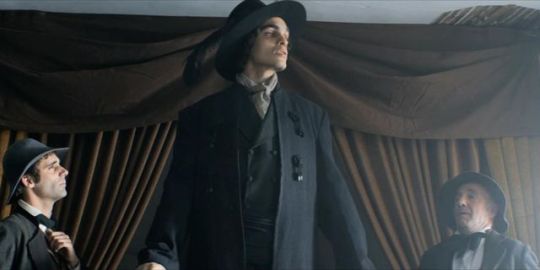
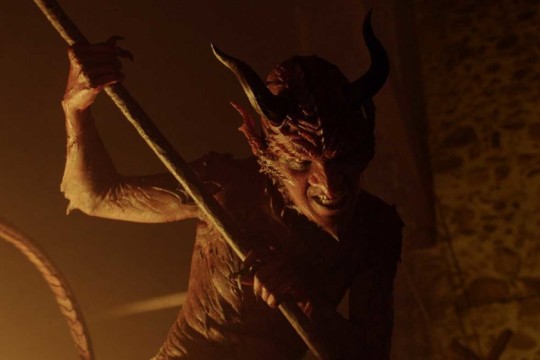
youtube
Eneko: Some beings have been created that I want to find in my nightmares. The public is going to be incredibly surprised with the beings that we are going to see during the film. I can not say too much... I think the work that has been done to put body and shape to all this that until now we have only had in our minds, in our imagination is precious and I think it is impressive and that the public is going to hallucinate.
Edurne: Wonderful. Special mention to David Heras because he is also a good friend and is working hard for the effects. It is another of the quadrangular stones that believe a lot in Irati. Him and his entire team, because let's not forget that there are like, I don't know, 120 people pixel by pixel, working to make it believable, so that this universe reaches the screens as big as possible. So this department is really crucial and Paul holds it in high esteem.
Itziar: I remember that I had an LED attached to my hand and to my body that, when she got angry, it turned on the LED, because well, this later with the effects... I didn't understand anything, all full of cables.
youtube
The first film by director Paul Urkijo, Errementari: The Blacksmith and the Devil, despite its defects, evidenced the author's intentions to exploit an almost intact beta in our cinema, that of folklore and peninsular legends.
Paul: We have such a large compendium of legends and there are many people who do not know them, that is a pity, that is, these legends are not transmitted for not giving them importance or taking them as a story, when they really are part of our culture, that is, they root us deeply in the world and our way of seeing the world. We also have to preserve these stories because they are precisely a lesson to preserve all this natural world that we have.
-To arms!
-Prepare for battle!
Now in Irati the director jumps back several centuries, specifically the 8th century to narrate, more accurately than its predecessor, the legend of Eneko, the first king of Pamplona. Once again with the participation of RTVE, shot in Basque, Urkijo repeats the leading role with Eneko Sagardoy, who faced the action challenge typical of these fantasies, apparently far from the actor's physique.
-That's enough, grandfather is waiting for me.
Eneko: He is one of the characters that I would never have thought that any casting director, for example, would have thought of me to play the king of Navarra who rides a horse, and such, that I put on 10 kilos based on sandwiches, cheese and milkshakes, and I gained a lot of muscle. I would never have imagined seeing myself like this or learning to ride a horse, to fight with swords very quickly and I think it was necessary.
Also in that case it was not a question of i Look, how I have transformed!, it was not binding, and it has been nice to see you physically transformed, it is always interesting.
-Calm down, what's up?
-The pain of the forest anguishes him
-This river is full of lamia tears. They left long ago with the construction of your hermitages and mills.
He takes as his starting point the first volume of the comic El Ciclo de Irati with which he builds a precious and careful story of magic and swords in which we witness the return of Eneko years after the battle of Roncesvalles in which his father lost his life. against the army of Charlemagne.
-Boy, you'll have to be strong to be a leader.
-To die!
-To arms!
Eneko will find himself in a region where the emerging Christianity and Muslims coexist with pagan beliefs. To reclaim his dynastic right, he will try to recover his father's body with the help of an enigmatic hermit, the beautiful Irati, played by the young debutant actress Edurne Azkarate.
-He appreciates you, he likes that you give him nuts
-How do you know that?
-Silence!
Paul: I've been able to make a movie three times as big, more serious too, although that adventure is also good, it's a movie with monsters and sword blows, but it's also a drama.
-Lamias...there are no such female creatures with bird feet
-A noble like you will have been with many women, right? Have you seen many feet?
We can affirm that Irati is the best to date, also almost the only magic and swords genre film in our cinema. It contains everything that fans of these formats of evocative adventure landscapes and magical beings such as lamias or mermaids and Basque mythology such as the mother earth goddess Mari or the tartalus, a kind of cyclops.
Paul: What I like is doing fantastic genres with creatures from fairy tale worlds, it's what I like the most, and it's what I want to continue doing as long as they let me.
Its technical envelope transmits a sensation of big-budget cinema, the care from the photography to the special effects or its impressive soundtrack and the epic of its story reminds us of productions such as the classic Excalibur or the recent The Green Knight, excellent distant cousins for a second work by a director to keep an eye on.
- Lamiak, Basajaun, mamarroak, Gaueko...
-Do they all have names?
-Yes, as long as someone remembers them
Previous interviews: Edurne Azkarate, Itziar Ituño
#irati#IratiFilm#films#interviews#paul urkijo#eneko sagardoy#edurne azkarate#itziar ituño#irati 2022#long post
12 notes
·
View notes
Photo

Irati (id., 2022)
#Irati#cine#póster#cartel#Paul Urkijo Alijo#Paul Urkijo#fantástico#fantastic#Eneko Sagardoy#Edurne Azkarate#cinema#movie#film#cinephile#cinefilia
6 notes
·
View notes
Text





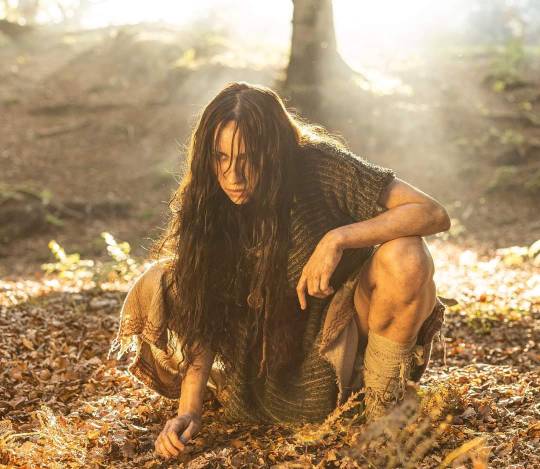


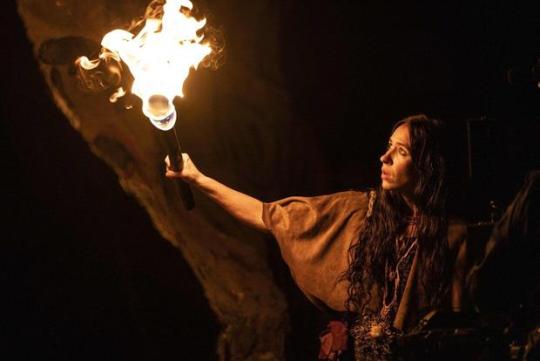
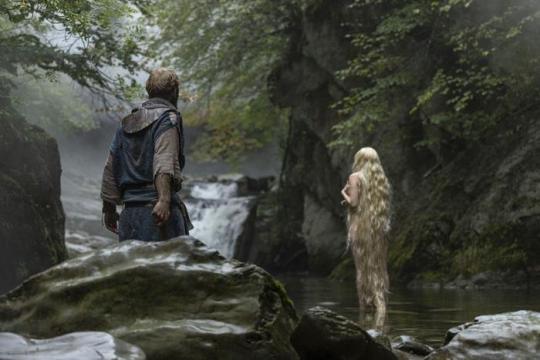
Irati (2022) dir. Paul Urkijo Alijo
#irati 2022#IratiFilm#irati#films#eneko sagardoy#edurne azkarate#elena uriz#iñigo aranbarri#iñaki beraetxe
19 notes
·
View notes
Text
@asongofstarkandtargaryen
Here's a video of Edurne Azkarate talking about her character Irati:
youtube
-Irati is a young, pagan, forest-dwelling girl, living through or still governed by the ancient laws of nature, with a great wound of abandonment
A tiny and weak heart, tiny like yours.
-She is a Mowgli girl who has very very very little family and her home is the land. Then, her entire destiny is cut short at the moment when, by force majeure in order to save the only person she loves in this world, she has to accompany, let's say, be a sherpa to a noble Christian, with all the threat that this entails supposes.
From here, the road is more difficult. Can you continue without falling?
-It was difficult, it was hard, but nothing that we could not fulfill with the team. So I felt very cared for. Little by little I was seeing that I was capable of getting the job done. It has been an experience, for me, very new, but very rewarding. It is true that what is always said, isn't it?, that, when a while passes, you only remember the good things, but, truly, I had a great time.
2 notes
·
View notes
Text
Brief mythological (and historical) dictionary of 'Irati'
@asongofstarkandtargaryen @queenmiriamele @luceirosdegolados @isadomna
Irati is a compendium of Basque mythology, it involves a review of many of its main figures, focusing on the "regent" of all creatures, the goddess Mari, embodied in the film by the actress Itziar Ituño. The filmmaker confesses that "many more" creatures appear in feature films than one is capable of perceiving, not in vain has he "played" to blur the lines between some mythological beings and others and to "mix". In an exercise of synthesis of the oral tradition, to which scholars such as the priest and anthropologist Joxe Miel Barandiaran dedicated a large part of their work, and with the desire to contextualize the spirit of Irati and the myths that through her gain new life, we offer you a small glossary of creatures, men and facts.
Aker: The goat is one of the beings that is not exclusive to Basque mythology, but also belongs to other traditions and religions. It is associated with the goddess Mari due to its healing abilities, but it is also associated with witchcraft. Not surprisingly, the term akelarre refers to the cult in which akerbeltz was venerated, an animal that, according to Barandiaran, was raised in homes to prevent cattle from getting sick. In fact, Barandiaran refers to him as a protective divinity. In different oral traditions of the Basque Country, he lives in a cave with a snake and is the custodian of a treasure. However, the witch hunt, which in the case of the Basque Country was promoted by Pierre de Lancre in the 17th century, caused the cult of the goat to be associated with the devil.
Basajaun: Being a giant humanoid in shape and covered in hair that lives in the depths of the forest or caves. This numen is related to traditional trades, with livestock, agriculture and blacksmithing. Thus, Basajaun is in charge of scaring the wolves to prevent them from attacking the sheep, which announce its presence with the unison ringing of their cowbells. The fact that it is considered the origin of various trades refers to the myth of Prometheus, the titan who stole fire from the gods to give it to humans, an act for which he was severely punished. According to Barandiaran, Basajaun was the first farmer from whom men, through deceit, obtained the first seed. The Gipuzkoan priest and anthropologist also highlighted that he is considered the first blacksmith and the first miller and, just like what happened with the first seed, the human being also stole the secrets for the manufacture of the saw, the axis of the mill and metal welding. Due to its characteristics it is also considered a jentil.
Eneko Aritza: Eneko Enekoitz, nicknamed Aritza (the oak or the strong), was the first king of Pamplona. The Latin sources name him as Enneco Ennecones, while the Muslims call him Wannaqo ibn Wannaqo. In this second feature film by Urkijo, he is played by Eneko Sagardoy and, along with the character played by Edurne Azkarate (Irati), he is one of the film's protagonists. The Álava filmmaker presents an Eneko before being crowned –he reigned between the year 824 and 852–. His father, also called Eneko (in the film he is played by Iñigo Aranbarri), was one of the leaders of the peninsular Vasconia who ambushed Charlemagne in Errozabal, in a contest that Otsoa Lupus II led from continental Vasconia.
Gentil or jentil: Wild giants of immense strength that lived in mountains or caves and were capable of lifting and throwing large stones. The jentil name is found in a multitude of Basque place names throughout the country's orography. The cromlechs and dolmens are, according to oral tradition, vestiges of these pagan builders who came to live in harmony after the spread of Christianity.
Lamia: Beautiful woman who combs her hair with a golden comb. Although it is anthropomorphic in shape, its feet can be those of a duck, chicken, or goat. It can be found on the banks of rivers and usually requires offerings, generally food (wheat, cornbread, cider, curd or milk). He usually rewards those who give him offerings in various ways. The philosopher Andrés Ortiz-Osés, in his work The Mother Goddess, in which he reflects on the figure of the goddess Mari and her cohort, speaks of the lamias as half nymphs and half mermaids, alluding to Greek and Latin myths. In this sense, Barandiaran neatly collected the different perspectives from which these beings have been described, either as numenas that help in farming or as beings that kidnap men on a whim. The advent of oxen-drawn plows (that is, technology) and the proliferation of Christian hermitages brought about the disappearance of lamias.
Mari: Main goddess of the Basque pantheon and one of the central figures in the film Irati. Urkijo highlights the telluric character of the deity and represents her as Mother Earth herself. As in Paleolithic religions, cavities represent the womb of life and she lives there, in the depths of a cavern, although paying attention to Barandiaran, she tends to periodically change homes by jumping from one mountain to another. She is the mother of the rest of the creatures that make up our mythology and, as Ortíz Osés explains, the goddess Mari is "omniparent", that is, she is the origin of everything and, at the same time, everything is linked. It usually appears combing her hair, cooking or spinning. The four elements converge in it and can be the source of storms and droughts. She is often consulted as an oracle and also rewards those who believe in her. It can be conjured by throwing or stacking pebbles.
Orreaga or Errozabal: In recent years, especially as a result of the investigations carried out by Xabier Irujo, the battle of Orreaga (the researcher claims the place name Errozabal) which took place in the year 778 has acquired new interest. The director of the Center for Basque Studies at the University of Nevada, Reno (USA), after almost a decade of studies using the original sources in Latin, denied many of the legends that have come down to our days, the majority of Frankish origin and that they were written 50 years after the death of Charlemagne (in the year 814) and also the events of the Chanson de Roland.
Before becoming emperor, Charlemagne, king of the Franks, undertook a campaign to develop the Hispanic March, a crusade whose objective was to consolidate a kingdom in the Pyrenees that would act as a barrier to prevent the advance of the Muslim kingdoms, after the start of their invasion in 711. With this objective he conquered the peninsular Pyrenees, that is, Navarra, including Pamplona. After failing in the attempt to conquer Zaragoza, Charlemagne, accompanied by 20,000 men, withdrew to Iruñea and, after destroying it, began the return trip through Errozabal, following a wooded path that connected Auritz with Luzaide.
Due to the narrowness of the track, the men had to march in a line, forming a line of between eleven and fourteen kilometers. It was then when the union between continental and peninsular Basques attacked the neck of the army, behind where the treasure was marching, producing what is known as the battle of Orreaga or Errozabal and which brought the defeat of Charlemagne's army, who fled from the fight and took refuge in Herstal, Belgium.
Irati seeks to be faithful to the latest research but, by ascribing to the sword and sorcery genre in the style of Legend or Willow, Urkijo did not want to miss out on the fantastic options that the Chanson de Roland allows.
Sugaar: A male snake. In some areas of the country, such as Ataun, Sugaar is a being that crosses the sky forming a fiery sickle figure. His presence announces the approach of a great storm. In other places, such as Azkoitia or Zarautz, on the other hand, the snake is the son and lover of the goddess Mari, as well as being the one who combs her hair. When both come together the heavens roar.
Tartalo: One-eyed man-eating creature. He is related to his Greek counterpart, Polyphemus, the son of Poseidon who was blinded by Odysseus in the Odyssey. Tartalo, according to Barandiaran, may be a corrupted version of Basajaun. Very present in the oral tradition of the municipalities of Goierri, Tartalo kidnaps human beings to devour them in the cave that he uses as his home and in which he lives with his sheep.
Zezengorri: In Basque mythology there are several animal-shaped numenas that share characteristic red skin. In addition to Zezengorri (red bull), we can find others such as Beigorri (red cow) or Zaldigorri (red horse). In any case, they are spirits from the subsoil whose objective is the defense of said cavities.
#irati#basque mythology#aker#basajaun#eneko aritza#gentiles#lamias#mari#orreaga#errozabal#sugaar#tartalo#zezengorri
28 notes
·
View notes
Text
Irati -> First trailer @asongofstarkandtargaryen
Year 778 A.C Western Pyrenees
"Your father did what he had to to protect our kind"
"Father!"
"When I'm gone one day you'll take care of the valley"
"Promise me"
"Boy, you'll have to be strong to be a leader"
"Eneko the young can't be a leader"
"I stand before the cross to be the Christian leader of the valley"
"Who?"
"Luxa"
"She is to blame for continuing to believe in pagan tales"
"There's a deep cave in the heart of the forest"
"You may find the answer there"
"My grandaughter will guide you."
"Irati"
"A soul flies tonight"
"To die"
"Don't stop!"
"I don't believe in tales"
Everything that has a name is
"To die"
"Irati"
"Forget my name and don't say it again"
Here's Irati's first trailer, it can be watched now in the Eitb (the Basque TV) web page. It looks promising!
Although I have read that probably the film will not be on cinemas until February 2023 :"(
Mythological aspects:
Wow! It seems that those creatures that appear between 1:13-1:18 are the Basajaun.
And in 1:18-1:20 probably it's when Eneko's father meets goddess Mari, because is her human form Mari is often described as a woman with abundant blonde hair that she combs, in the sun, with a golden comb. Probably Mari will be the one who unleash the storm during the battle.
I love the transition between 0:46-0:48, showing a sculture of Maria and then a cave art that represents Mari, showing the theme about syncretism of the Basque mythology into Christian beliefs:

In the cave art it can also be seen a symbol inside Mari, that seems to be a kind of representation of god Sugaar or Maju in form of a lauburu with some more arms.

Sugaar or Maju is Mari's husband, and usually is represented as a giant snake or a dragon. It represents elements of fire and air, meanwhile Mari is often linked to water and earth. He travels from one place to another as a ball of fire.
Mari and Sugaar have two children, Atarrabi and Mikelatz, who represent the goodness and evilness, and in some other legends, Eguzki and Ilargi, the sun and moon goddess, respectively.
Although Sugaar has other son with the princess of Mundaka, Jaun Zuria, the mythological first Lord of Bizkaia.
It is said that Mari lies with Sugaar on Friday, the day when ancient akelarres were celebrated, and they cause strong storms.
The lauburu symbol is often linked with them because the lauburu represents the sun, but also the four elements: earth, water, air and fire, and male and female duality.
Historical aspects:
About the setting of the film, it looks like the film will start by the first battle of Roncesvalles/Orriaga in 778, when Eneko is a kid, and great part of the film will be set in the late 790's when Eneko is already an adult.
Knowing that the film is inspired in the El Ciclo de Irati comics (which one day I will do a couple of posts about them), I believe that is very possible that this Eneko is Eneko Arizta/ Eneko Enekoitz or Iñigo Arista/Iñigo Íñiguez, in castilian, (770-854), son of Eneko Semenoitz (Iñigo Jiménez) and Oneka of Pamplona/Oneka Iruñekoa, Lord of Pamplona and founder of the Arista-Íñiguez dinasty, and in the past he was considered the first "king" of Pamplona (Iruña)/Navarra (Nafarroa), although it has been currently studied that he wasn't truly a king, but his descendants were.
Some time after her husband died, Oneka converted to Islam and married Musa ibn Fortún ibn Qasi (740-788), chief of the Banu Qasi clan, walī (governor) of Arnedo, Zaragoza and Tarazona. Their son was Musa ibn Musa al-Qasawi, known as Musa the Great (Arnedo, La Rioja, 785-Tudela, Navarra, 862), walī of the al-Ṯaġr al-Aʿlà, the Upper March of Al-Andalus, that was formed by the territories of Tudela, Huesca, Zaragoza and Lleida.
Several marriages between the members of the family happened several times during the following generations. Although in some circumstancies they fight against each other because of alliances with the kingdom of Asturias or the emirate of Cordoba.
When Ludovico Pio sent an army to try to take Pamplona , they attacked the city and in response they were defeated again in the Pyrenees in 824 the second battle of Roncesvalles/Orriaga by a group of basques and aragoneses lead by Eneko, Musa and Gartzia.
Apart from being his brother, Musa married one of Eneko's daughters with Oneka Velázquez of Pamplona/ Oneka Beraskoitz Iruñekoa, Assona.
The other daughter of Eneko, Nunila, married García Galíndez/Gartzia Garindoitz "the Bad", who became count of Aragón after Eneko overthrowed the former count of Aragón (Gartzia's former father-in-law ) Aznar I Galíndez/ Azeari Garindoitz because he was pro-Frankish. Charlemagne and his heirs formed the Hispanic March formed by a bunch of counties, dependent to the carolingian empire like Barcelona, Girona, Urgel Pallars, Ribagorza, Roussillon, Cerdaña, Ampurias, Sobrarbe and Osona, and other ones like Pamplona/Navarra and the county of Aragón, that became independent sooner.
And Pamplona/Navarra and the county of Aragón as ally/vassal of Navarra managed to keep independence.
(I don't think that the film is going to reach the events of the second battle, but it would be good for a sequel)
#irati#trailer#eneko sagardoy#edurne azkarate#videos#irati 2022#itziar ituño#basque mythology#history#mari#sugaar#basajaun#eneko aritza
15 notes
·
View notes
Text
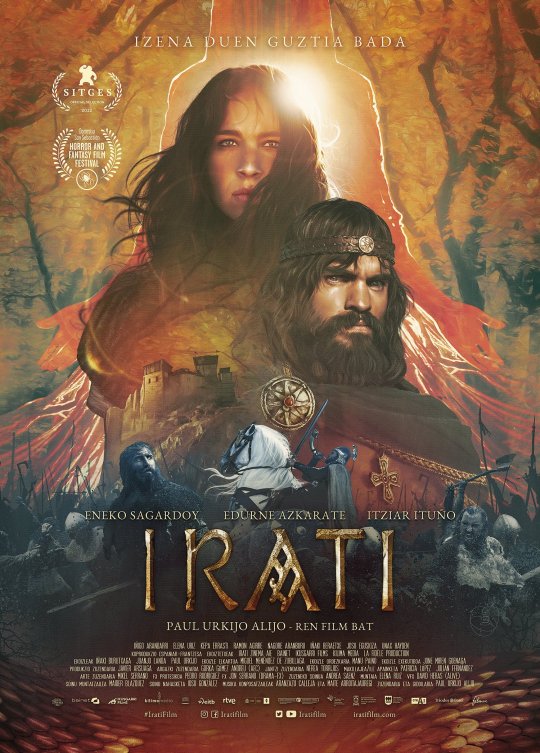
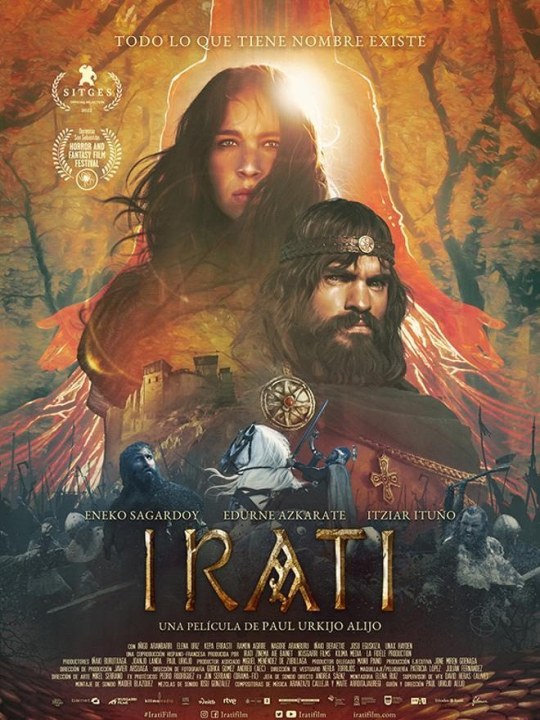
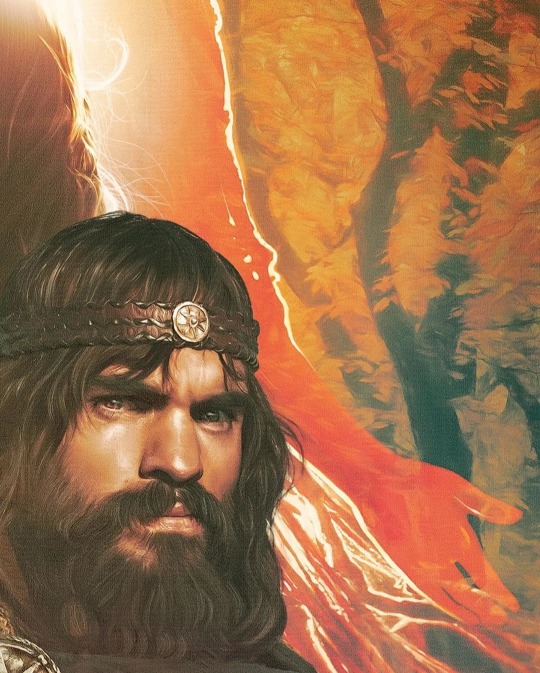
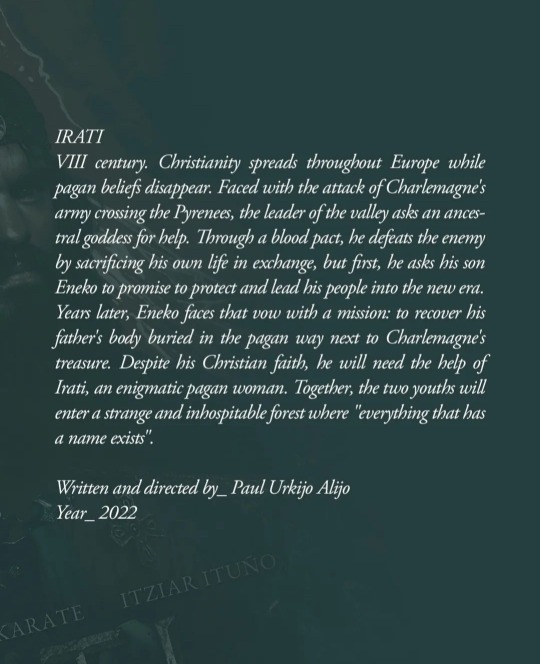
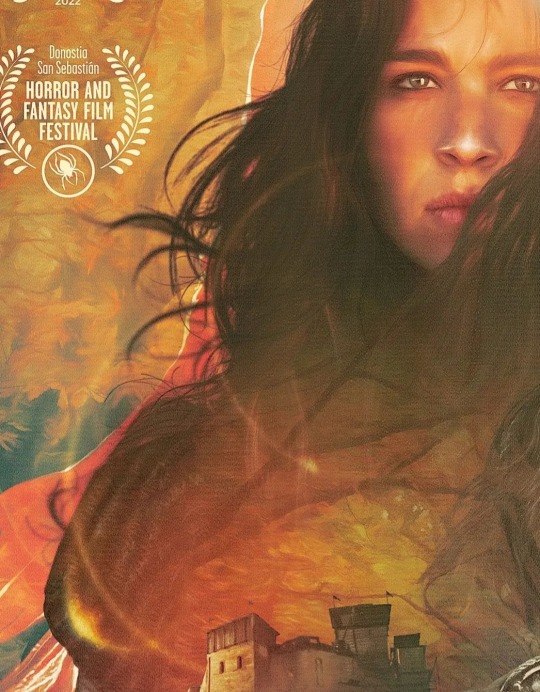
Irati -> Posters @asongofstarkandtargaryen
Release date: February 24, 2023
6 notes
·
View notes
Text
More pics from Irati @asongofstarkandtargaryen

Eneko Ximenez at the battle of Roncesvalles/Orriaga

Kid Eneko Arizta
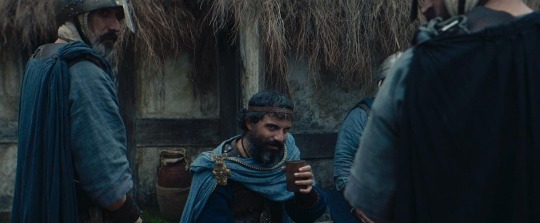

Belasko
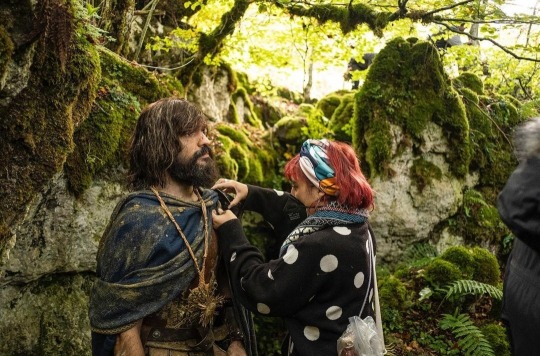
Here's another pic from the filming. It's interesting because Eneko is wearing an amulet of a Eguzkilore.
The Eguzkilore: is a flower of the thistle Carlina acaulis, "the flower of the sun", named for the similarity of its shape with the sun.
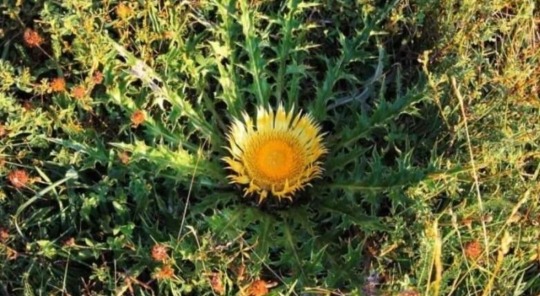
According to basque mythology, Amalur, mother earth, created the Eguzkilore to protect humans from evil spirits. A thistle, which, located at the entrances of houses throughout the Basque Country, Navarra and other places of Aragon and Catalonia, symbolizes the sun during the hours of darkness, at night, thus preventing the entry of all evil beings.

This plant and its roots were essential during the plague epidemic that devastated the peninsula during the reign of Charlemagne. And it is that, according to what they say, the antibiotic properties of Eguzkilore helped to deal with this pandemic, hence its name, Carlina, from Charlemagne.

The Eguzkilore probably is going to be an important element of the film. In the Donosti Festival Edurne Azkarate is carrying a piece of wood with a Eguzkilore.
Probably Luxa or Irati gave Eneko a eguzkilore as a protection amulet.

Also the brooch of adult Eneko's outfit could be a reference to the Eguzkilore (idk the form reminds me of that) and the brooch also could be a reference to the coat of arms and the banner of the Kingdom of Navarra (and current COA of the community of Navarra), at least from the central part of the COA.
Pamplona/Navarra will not be a a kingdom until Sancho Garcés I in 905, but maybe this could be a symbol shown in the film, that in the film-universe would be recurrent and would derive into Navarra's banner.
One heraldy symbol related with Eneko is the cross of Eneko Arizta (A silver cross, kick pointed at its lower arm, located in a frank barracks, on a field of azure). It was used as part of the heraldy of Aragon (X), attributed to be Eneko's sigil, but probably that wasn't the case, and it could be a way of the Aragonese monarchs to reaffirm Eneko as their antecesor (although looking into the genealogy, the rulers of the Crown of Castile, Aragon, Portugal and even the Caliphate of Córdoba were descedants of Eneko). It has been used in Aragonese heraldy since Sancho Ramírez (ca. 1043–June 4, 1094), I of Aragon and V of Pamplona. This is his sigil (x).
There are some examples of personal sigils of some Aragonese kings with the cross: like the one from Peter IV (×), one of the sigils of Alfonso V and John II (X)(×) and one of the sigils of Ferdinand II (x)(X)
The cross of Eneko is also part of some coat of arms nowadays, like the shield of the community of Aragon (x) or the one from the Valencian Community (x).
In one of the covers of El Ciclo de Irati comics Eneko appears with a shield of an eagle (×) (in addition, the artwork of the eagle of the shield reminds me a bit of these Visigothic aquiliform fibulae from Alovera) it's similar to the sigil of Sancho VII of Navarra "the Strong" (Tudela, April 17, 1154 -Tudela, April 7, 1234), the last king of the Jimena dinasty in Navarra, his successor was his nephew, Theobald I "the Troubadour" (Troyes, May 30, 1201-Pamplona, July 8, 1253), son of Blanche of Navarra and count Theobald III of Champagne. The sigil of Sancho, a black eagle on a red field (×), is considered the primitive coat of arms of Navarra, but it was switched with the current carbuncle sigil.
Bonus track:
Sometimes in the Aragonese royal heraldy apart from the mantel with the cross of Eneko, ther was also the Royal Crest, that in Aragon was a dragon (×), or the old crest with a bat (x) and a black eagle for Sicily (×).
For the heraldy od Aragonese monarchs of Naples, the crest of the dragon was also used, for example the one from Alfonso V's bastard son, Ferdinand I of Naples (×)
The support may differ, for example Ferdinand II's sigil in his late years have two griffons as supports (×)
The royal crest of Navarra was the feathers of a peacock (×). For example, one of the sigils of John II of Aragon uses this crest (×), as king of Navarra. There's a contrast between the main sigil (x). Probably the two greyhounds have the helmet on their heads covering their eyes because for several years John was blind.
He suffered from cataracts, until on October 12, 1468, at the age of 70, he recovered his sight thanks to the Catalan Jewish surgeon Cresques Abnarrabí who operated the king on both eyes.
Apart from the Navarrese monarchs, John of Austria (Philip II's bastard brother) used a peacock feather crest in one of his sigils (×)
The royal crest of Castile was a lion and a castle (×) and there was an old one with a griffon (×). And the supports of the Castilian coat of arms were often two lions, like the heraldy of John II of Castile and Henry IV (×) or Isabella I (×)
The royal crest of Portugal was a dragon(×) and the supports of the COA were two green dragons (×)
During the Iberian union during the reigns of Philip II, Philip III and Philip IV (before Portugal became independent again) the coat of arms included the Royal crest of the Crown of Castile, Aragon and Portugal (×)
#irati#films#pics#costume design#eneko sagardoy#edurne azkarate#paul urkijo alijo#nerea torrijo#iñigo aranburu#kepa errasti#history#heraldy
3 notes
·
View notes
Text

It has been announced that Irati has achieved 20 nominations for the Goya Awards 2023! It was very successful at the Sitges and Donosti Film Festival this year, so I'm sure it will be great. @asongofstarkandtargaryen
Best Film: Iñaki Burutxaga, Joanjo Landa, Miguel Menéndez de Zubillaga, Paul Urkijo Alijo
Best Director: Paul Urkijo Alijo
Best Adapted Screenplay: Paul Urkijo Alijo
You can read the script here (It's mainly translated to Spanish. The film will not be on cinemas until next year, so this is a bit of spoiler)
Best Original Music: Aránzazu Calleja, Maite Arroitajauregi "Mursego"
Listen to it
Best original song: "Izena duen gutzia bada" - Composers: Aránzazu Calleja, Maite Arroitajauregi "Mursego", Paul Urkijo Alijo
Listen
Best Leading Actor: Eneko Sagardoy
Best Supporting Actor: Iñigo Aranbarri, Kepa Errasti, Ramón Agirre
Best Supporting Actress: Elena Uriz, Nagore Aranburu
Best new actress: Edurne Azkarate
Best Production Direction: Javier Arsuaga
Best Director of Photography: Gorka Gómez Andreu
Best montage: Elena Ruiz
Best Art Direction: Mikel Serrano
Best Costume Design: Nerea Torrijos
Best hair and makeup: Patricia López, Julián Fernández, Pedro Rodríguez "Pedrati"
Best sound: Andrea Sáenz Pereiro, Maider Blázquez, Iosu González
Best special effects: Jon Serrano, David Heras
#irati#films#paul urkijo alijo#eneko sagardoy#premios goya 2023#edurne azkarate#itziar ituño#nominations
1 note
·
View note
Text




Eneko and Edurne in the filming of Irati
@asongofstarkandtargaryen
1 note
·
View note
Text

@asongofstarkandtargaryen
The music composers from Irati are the same from Akelarre (Coven of Sisters), Maite Arroitajauregi and Aránzazu Calleja.
#irati 2022#irati#paul urkijo alijo#eneko sagardoy#irati ost#soundtrack#edurne azkarate#maite arroitajauregi#aránzazu calleja#eitb#period dramas#poster
1 note
·
View note
Text


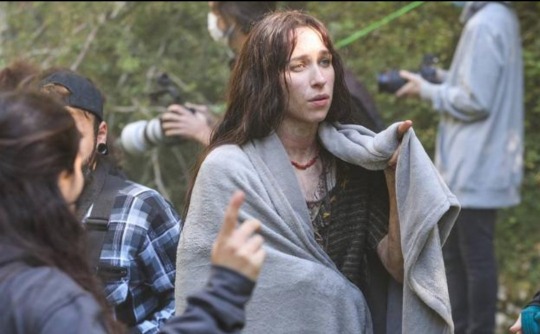
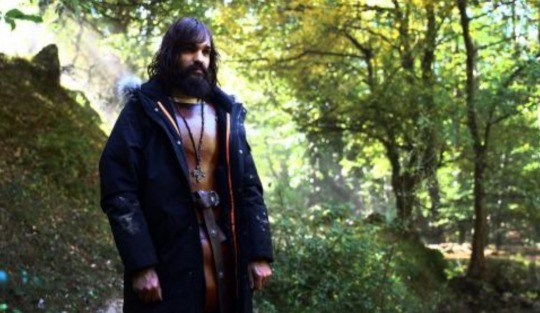





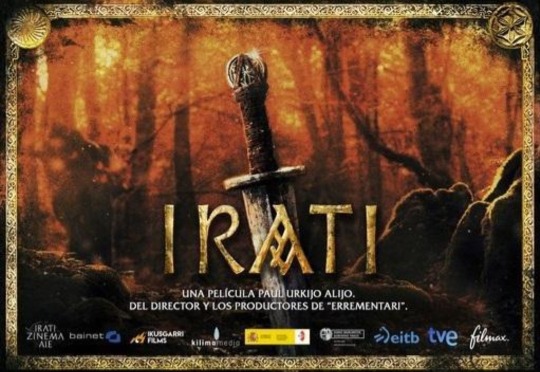
@asongofstarkandtargaryen
Irati (2022)
8th century, Christianity spreads across Europe while pagan beliefs disappear. Faced with the attack of Charlemagne's army crossing the Pyrenees, the leader of the valley asks Mari (Itziar Ituño), the goddess of weather, justice and nature, for help. Through a blood pact, he defeats the enemy by giving his life in exchange, but first, he makes his son Eneko (Eneko Sagardoy) promise to protect and lead his people in the new era. Years later, Eneko faces that promise with a mission: to recover the body of his father buried in a pagan way next to Charlemagne's treasure. Despite his Christian faith, he will need the help of Irati (Edurne Azkarate), an enigmatic pagan woman from the area. The two young people will enter a strange and inhospitable forest where "everything that has a name exists".
The main locations of the filming are Araba, Gipuzkoa, Bizkaia, Navarra and Huesca, like the castle of Loarre and the caves of Arrikrutz, Leze and Pozalagua.
Premiere: 18th November, 2022
Cast
Edurne Azkarate: Irati
Eneko Sagardoy: Eneko
Itziar Ituño: Mari
Nagore Aranburu: Oneka
Elena Ruiz: Luxa
Iosu Eguskiza: Odon
Kepa Errasti: Belasko
Iñaki Beraetxe: Ximeno
Iñigo Aranburu: Eneko X.
Ramón Agirre: Virila
Miren Tirapu: Munia
Aitor Barandiaran: Anso
Gaizka Txamizo: Berex
Gabriel García Muñoz: Warrior
Iñigo Aranbarri
Technical team
Directed by Paul Urkijo
Executive Producer: Jone Miren Goenaga Paul Urkijo
Writer Assembly: Elena Ruiz
Original music: Aranzazu Calleja and Maite Arroitajauregi
Production direction: Javier Arsuaga
Director of photography: Gorka Gómez
Art direction: Mikel Serrano
Air freshener: Izaskun Urkijo
Production Manager: Mikel Huercanos
Head of Sound: Andrea Sáenz Pereiro
Head of Makeup: Patricia López
Head of Hairdressing: Julián Fernández
Casting director: Txabe Atxa and Florencia Inés González
VFX Supervisor: David Heras (ALIVE VFX)
Sound editing: Iosu Gonzalez
Special Effects: Drama FX
Prosthetic makeup: Pedro Rodriguez
Paul Urkijo: "Irati is the fantastic medieval historical adventure film that I have wanted to tell all my life. I have always been fascinated by Basque Mythology and Irati is an epic tribute to that dark and fascinating world of legend. Freely inspired by characters from the graphic novel 'El Ciclo de Irati' by J. L. Landa and J. Muñoz as well as other Basque legends and historical events such as the battle of Roncesvalles. It's about a young nobleman named Eneko who has to prove his worth to be the leader of the valley like his grandfather was. For which he will end up entering a strange and mysterious world full of ancient mythological deities helped by a young pagan from the place named Irati. It is set in the Basque Pyrenees of the 8th century, a dark but fascinating medieval era. Where the hegemonic religions (in Christianity and Islam) fight each other, causing pagan beliefs to disappear along with arcane deities linked to nature."
14 notes
·
View notes
Text





@asongofstarkandtargaryen some more scketches of the Costume Design for the characters of Irati.
I found an article with an interview of the costume designer Nerea Torrijos about the designs:
"The film consists of three color blocks. The cold ones for faith, of any kind, are for Christian or Islamic characters, which is why we can see that Oneka and her guards wear turquoise and teal, for example. The warm ones identify the pagan world that still survives in Irati. And the browns, browns and earth tones represent the local, the mountain, the Basques. In "Irati" there is a great color work to be able to separate the different worlds of our characters very well and achieve that well-cared aesthetic.
The protagonist, Irati, is played by Edurne Azkarate. Her design had to be something organic, as if it were part of the forest where she lives. She is wild. Her clothes seem to be made of moss or small intertwined sticks, to achieve an outer layer that helps them blend in and go unnoticed in such an environment. Her entire look is in green brown tones and earth colors with a detail in warm tones on her dress.
Eneko, the male lead played by actor Eneko Sagardoy, wears a slightly Roman look, because Paul was always very clear that this is what he wanted. The tunic he wears is black because the Basques and Navarreses dressed like that in those centuries. This is information that I collected from the Codex Calixtinus, where a monk who passed through this area at that time tells it.
Over the tunic, Eneko wears a brown leather coat, since the brown tones are those that represent the roots to the earth and to the mountain. The puffer jacket has, both on the tabs and on the neck, the oak leaves representing Eneko's nickname, which an artisan saddler that I had on the team shaped by hand, one by one.
Eneko wears a blue cape, as this color in the movie represents faith, as I noted earlier. And in this case, his cloak protects him, as does his faith in God. His crown and fibula, made of metal, are his family insignia, which we created for the film. And he wears sandals with black sheep hair leggings, for the cold. Finally, the maroon embroidery that Eneko wears on his tunic is the color of the future flag of Navarra that he will found. We did it as a historical license, yes, but it seemed nice to me. "
Now the family is completed, there's the costume design for Musa (although maybe he's not Musa Ibn Musa, and it's his father Musa ibn Fortún that is shown around the battle of Roncesvalles, or maybe he's in fact Musa ibn Musa and he travels with Oneka to see Eneko later in the film).
And there's some alternative designs, a design for young Oneka, and a special design for Eneko, that I bet it's related with the track Eneko Jaun (Lord Eneko), maybe it's his clothing during a ceremony when he'll be named/"crowned" Lord of the valley or Lord of Pamplona by the end of the film.
3 notes
·
View notes
Text
@asongofstarkandtargaryen the interview I told you about. And the release date of the film is on 18th November. Although it will be during the Sitges Film Festival (6th-16th October)
Here's the link to the interview, but it's in spanish so I've translated to make it easier. It's from February, but it has some interesting info.
Paul Urkijo: "Mari is the most powerful character in Basque mythology"
Paul Urkijo is in love with mythology in general and Basque mythology in particular. His films drink from those sources that fill the narratives of ancient legends. The director from Alava has finished 'Irati', his second film after Errementari.
Irati is a fantasy of medieval Euskadi, and Paul Urkijo places the action in the 8th century. The plot revolves around a group of Christian and Muslim warriors who enter the Basque Pyrenees in search of a lost treasure of the Emperor Charlemagne. And it is supposed to be in a cave, according to the locals, guarded by the goddess of the lands, Mari. The group of warriors, led by Eneko, is led by a mysterious young woman from the area named Irati. The film stars Eneko Sagardoy and Edurne Azkarate, and the story begins in a comic by Juan Luis Landa and Joxean Muñoz. Talking with Urkijo means immersing yourself in a world of swords and witches
You studied Fine Arts. Was your idea the audiovisual world?
I originally got into this career to do illustration, and my intention was to go into comics or animation. That was what I thought from my way of making and creating stories. I discovered the audiovisual in Fine Arts. Until then it had never crossed my mind that I could make movies, and even less so here; at least, not the kind of cinema that I liked.
Why did you think you didn't have that chance?
Because the cinema that I like is the fantastic genre. When I was 18, I didn't consider those kinds of possibilities. That yes, the cinema is what I have liked most in life, since I was a child, but at that time what I did the most was draw. In Fine Arts I began to discover the audiovisual world because I had several film subjects, and little by little, making short films, I realized that this was going to be my way of telling stories.
And drawing?
It was also included. In the pre-production of a film there is a lot of drawing, so I was immediately hooked on the audiovisual world. At first I made short films with friends to have fun where we used a lot of ketchup, a lot of tomato.
It seems you like it bloody.
Ha, ha, ha. It has its appeal. Every time I was doing more complex things. Little by little I became a professional, and they were no longer just stories with friends to have fun. I wanted what I was experiencing to be my profession. I took a 3D course, I got an award at EITB Kultura and with 2,000 euros I made a short film, El pez plomo, my first work that can be considered semi-professional.
And Errementari arrived
Well, not so fast. Before I did about fifteen shorts. It was a while before he launched me into making a feature film, and that was big words. It seems that he is a big fan of Barandiaran. Of course, and I can also be very monothematic. I have always been a fan of the fantastic and mythology on an international level. Monsters have fascinated me ever since I was a child. I like the meaning of stories and everything behind them. It is a very nice way to describe ourselves, a way to talk about our darkest things and our brightest moments. I am from where I am and from a very young age I have been deeply touched by Basque mythology. I had stories, I went to the mountains a lot, I visited caves... My aitas (aitas=parents in basque) took me to very interesting places and told me stories.
Stories that you now turn into movies.
Ha, ha, ha. Yes, it can be said that from those stories later came others that have become shorts and movies. At home we had an edition of Barandiaran's Complete Works, and I also bought books, although more modern. Little by little I became interested on a deeper level. I saw in those stories what I needed and wanted to tell.
What did you see in Errementari
A fantastic genre story, fun, but dark and with demons; an imagery that I love, so developing all that, I knew it was perfect. I had a really good time making that movie.
Between Errementari and Irati
Yes. I had always wanted to make a fantastic film, with a historical genre and Basque mythology. I was in love with the idea of doing something sword and sorcery, and this comic had enough ingredients to make the movie that I wanted. He had certain nuances that made me go headlong toward him. It drinks directly from Basque mythology and has the perfect excuse to be able to combine history and mythology. I was inspired by the main characters, but I went to the origin.
Did it go off script?
In a way. Yes, I passed a little on the aesthetics, the tone, even the narration of the comic, and in the end I have done something totally different. People who expect something similar to comics will not find it in Irati. It is a much more adult narration, which delves much more into what for me is Basque mythology. It gets a lot into the symbology of those telluric characters related to nature and the beliefs that pagan people had, as opposed to other religions that came later.
It has dropped a lot, from the 21st to the 8th century.
I am not a historian; I am a fan of history and my profession is to tell stories, especially fantasy genres. I use historical settings and periods to immerse the viewer in the lives of my characters, and the 8th century is a fascinating time.
Although seen from a distance of thirteen centuries apart, it seems like a very dark time.
There is no documentation at all. There are very few engravings, there are very few codices, there are very few writings, but in every dark age there have been lights. Christianity has not established the iconography that we are going to see later in the churches. We meet pagan deities who are later transformed into Christian deities. It is a game that is very present in the stories of Barandiaran, where there is always a game between the Christian and the pagan.
Irati is one of the main characters, but many will think that the title refers to the Irati jungle, in Navarra.
I play with that idea. The protagonist is Eneko, a young Christian and nobleman who aims to be the leader of the area, while she is a pagan girl. In order to complete his mission and be the Jaun (lord in basque), Eneko will need the help of Irati. With it you will immerse yourself in that inhospitable, magical and dark jungle that we call Irati.
You have fulfilled your fantastic goals with two films like Errementari and Irati
Ha ha ha. I would love to, because those movies are much easier to produce. I have current stories and projects planned for the future, but right now, what comes to mind is from the period and in complicated locations, with swords, with monsters. After this film, which has been a great epic at the production level, I would like to do something simpler, to rest.
What is the Basque territory that treasures the most mythology?
It is difficult to choose and they all share mythology.
You have chosen Mari.
And Mari is in all herrialdes. Language unites us. Mythology comes to us through oral transmission, and in Basque. There are many studies linking Mari to a matriarchal goddess who was part of a religion that was all over Europe.
What is your favorite character within the mythology of Euskal Herria?
Mari, so we go back to her. It has a power so deep that it is part of all of us. It represents Amalurra, the mother of all creatures. It is fair and terrible in equal parts. Mari is the most suggestive and powerful character in Basque mythology. It is exciting in all the forms it can take: fire, storm, gold, skeleton, snake and all possible animals. It is a unique character that is within my dreams.
And your dreams are about monsters, witches, storms, darkness. A nightmare?
Ha ha ha. No. When I think of monsters, I dream of empathizing with them. They are not a nightmare. I like them because I try to see the other side, because I see the incomprehension that exists in this world towards creatures that are different.
How long has the filming of your film lasted? Eight weeks
Is it a lot or a little?
For what is usually done in independent cinema, it is a lot. We have had the help of the Basque Government, EITB, TVE, the Gasteiz city council. Many people have helped us. Thanks to all of them we have been able to produce a fantastic genre film in Basque. This has been a very complicated project, but I am very stubborn. It's been four or five years of development. Today, making an eight-week film is very complicated. Normal is between four and five.
What route do you think Irati is going to have?
We're in post-production and thinking about the fall festivals. We want to treat the film in the most traditional way possible.
Cinemas?
Exactly, and then it will go to platforms, that's the world we're in. We want it to go to cinemas, festivals and everywhere possible. It is a film that I have tried to make as big as possible. I have wanted to make an epic film so that it can be seen on a cinema screen.
Can you tell who finds Charlemagne's treasure?
No. For that you will have to wait and see the movie, and that is if Charlemagne's treasure exists.
What does a filmmaker like you live on when the cameras are turned off and the story is already finished?
There were times when I had to work doing everything. I've been a waiter, I've been on assembly lines, as a drawing teacher. Of everything. When you go to feature film and make a movie you try to save up to last the time it takes to get to the next one.
In this case, five years, how much does it stretch the money?
Ha ha ha. That valley is usually usually tricky. Let's say that the illusion is what pushes you and you have to cling to it a lot so as not to get sidetracked thinking that you have to pay the flat.
Is Basque cinema in fashion?
I think we're doing pretty well. There have always been great Basque films, but perhaps since Aupa Etxebeste! our cinema has taken off. From a certain point, films have begun to be made in Basque that are consumed nationally and internationally.
Handia was about to go to the Oscars.
The Moriarty production company is the spearhead of Basque cinema. What others do affects us, just as what I do affects others. I think that in Basque cinema we feed off each other, and all at the same time we are creating an increasingly professional, increasingly stable industrial fabric, and that is why we have more and more work in the Basque Country. For example, it is very difficult to find technicians for a film. When we went to do Irati we had a hard time, because they were in other series and other movies. We have a good outlook.
Would you like to make non-independent cinema?
Yeah, of course. Maybe you don't have as much creative freedom, but at an industrial level you can make very big, contrived and fun movies, it wouldn't be bad at all. It is also true that I make films because I like to tell my own stories.
Do you think that in the end we will end up seeing all the movies on platforms?
I think and hope not. People, with this pandemic, have stayed at home and have gotten used to watching movies there, but I think the time will come, if it hasn't already, when people once again have the need to share the films in larger spaces, where the experience is different. I am hopeful that theaters will be strong again.
And with popcorn included, right?
That of course. A good movie and a good carton of popcorn. We will return to it and we will see the cinema as we have always seen it, in theaters. It is true that I have also gone less because of the situation we have been through, but I have tried to go to a room every week.
In your first film you used three dialects of Basque. In this one?
A dialect of Basque, Latin and Arabic. These last two languages are brushstrokes that we have put. Basque is Navarrese with a very old nuance, but totally understandable. All this will help us immerse ourselves in that time, the 8th century.
Does your movie has age restrictions?
No, my film is immortal. Seriously, it's an adult movie, I haven't limited anything, but totally understandable. All this will help us immerse ourselves in that time, the 8th century. Is your movie old? No, my film is immortal. Seriously, it's an adult movie, I haven't limited anything, but I think it's a movie that everyone could see. It is an adventure story, entertaining, with its dark moments, with violence. I'm not going to be the one to categorize it. Hopefully the younger ones will see it too.
**********
About the director...
Age: 37 years old (June 22, 1984).
Place of birth: Gasteiz.
Education: Bachelor of Fine Arts.
Career: Once he discovered the audiovisual universe in college, he launched himself into the world of short films. His works in this field have won 85 national and international awards and have been selected for festivals some 400 times. In 2016 he wrote the bible for his first feature film, based on the Basque story Patxi Errementaria. With this film he has won numerous awards, including the award for best film at the Terror Week in San Sebastian. Five years later, he has returned to command to make his second feature, Irati, an epic story that will travel through the autumn festivals.
3 notes
·
View notes